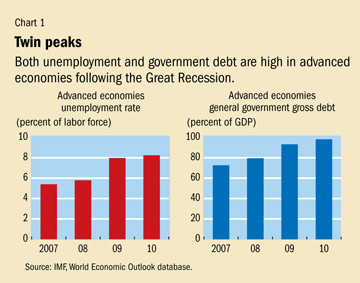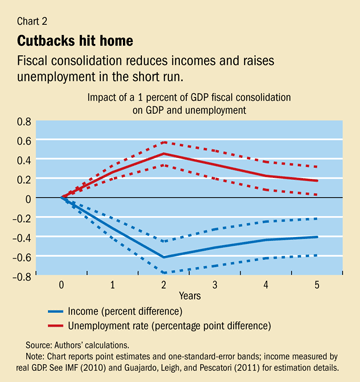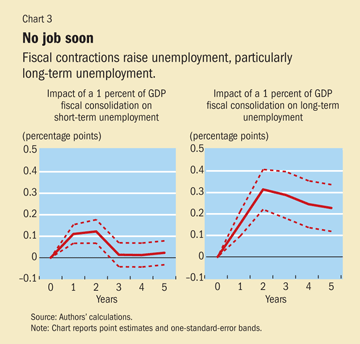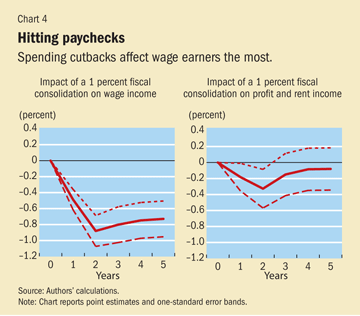Painful Medicine
Finance & Development, September 2011, Vol. 48, No. 3
Laurence Ball, Daniel Leigh, and Prakash Loungani
Listen to our podcast: Managing the Pain of Fiscal Consolidation ![]()
Although advanced economies need medium-run fiscal consolidation, slamming on the brakes too quickly will hurt incomes and job prospects

WHEN British Prime Minister David Cameron announced his government’s deficit reduction plans earlier this year he said, “Those who argue that dealing with our deficit and promoting growth are somehow alternatives are wrong. You cannot put off the first in order to promote the second” (Cameron, 2011).
The challenge facing the United Kingdom and many advanced economies is how to bring debt down to safer levels in the face of a weak recovery. Will deficit reduction lead to stronger growth and job creation in the short run?
Recent IMF research provides an answer to this question. Evidence from data over the past 30 years shows that consolidation lowers incomes in the short term, with wage-earners taking more of a hit than others; it also raises unemployment, particularly long-term unemployment.
For the advanced economies, there is an unmistakable need to restore fiscal sustainability through credible consolidation plans. At the same time, we know that slamming on the brakes too quickly will hurt the recovery and worsen job prospects. Hence the potential longer-run benefits of fiscal consolidation must be balanced against the short- and medium-run adverse impacts on growth and jobs.
The twin challenges
The Great Recession of 2007–09 has led to the most pronounced increase in unemployment the advanced countries have seen in the post–World War II period. Unemployment averaged 5 percent in 2007 but shot up to 8 percent by 2009 and has remained high since then (see Chart 1, left panel). In many countries, such as Ireland and Spain, unemployment is at double-digit levels; in the United States, two year after the recession was officially declared to have ended, unemployment remains above 9 percent and net job creation is at a virtual standstill.

The Great Recession has also been a factor in increasing public debt, in large part because of the collapse in tax revenues as incomes fell. Other contributors to the debt buildup were the costs of financial bailouts of banks and companies and the fiscal stimulus provided by many countries to stave off a depression. In advanced economies public debt has increased from 70 percent of GDP in 2007 to about 100 percent of GDP—its highest level in 50 years (see Chart 1, right panel). Looking ahead, population aging could create even more serious problems for public finances (see F&D, June 2011).
Will it hurt?
Many governments are already undertaking or planning policies to reduce government debt and deficits (fiscal consolidations), through a combination of spending cuts and tax hikes. What are the likely short-term effects of these plans?
Because such plans have been quite common, history offers a good guide. Over the past 30 years, there have been 173 episodes during which 17 advanced economies undertook budgetary measures aimed at fiscal consolidation. (The countries are Australia, Austria, Belgium, Canada, Denmark, Finland, France, Germany, Ireland, Italy, Japan, the Netherlands, Portugal, Spain, Sweden, United Kingdom, and the United States.) The average size of fiscal consolidation was about 1 percent of GDP a year.
To obtain estimates of the effects of fiscal consolidation, the IMF research draws on historical accounts and records of policy actions—tax hikes and spending cuts—motivated by a desire to bring about deficit reduction. This is a more accurate measure of policy actions than those used in previous studies, which often rely on the observed change in the budget deficit adjusted for the economic cycle (see box).
Measuring fiscal consolidation
The measure of fiscal consolidation used in this article focuses on policy actions—tax hikes or spending cuts—taken by governments with the intent of reducing the budget deficit. This may seem to be the natural thing to do but it is not the way fiscal consolidation has been measured in previous studies (e.g., Giavazzi and Pagano, 1990; and Alesina and Ardagna, 2010).
In previous studies, fiscal consolidation is measured by successful budget outcomes. Specifically, the cyclically adjusted primary balance (CAPB)—the primary balance adjusted for the estimated effects of business cycle fluctuations—is used as a measure of fiscal consolidation. The cyclical adjustment is needed because tax revenue and government spending move automatically with the business cycle. The hope is that, after this cyclical adjustment, changes in fiscal variables reflect policymakers’ decisions to change tax rates and spending levels. An increase in the CAPB would therefore, in principle, reflect a deliberate policy decision to cut the deficit.
In practice, however, budget outcomes turn out to be an imperfect measure of policy intent. One problem is that the cyclical adjustment suffers from measurement errors. In particular, it fails to remove swings in government tax revenue associated with asset price or commodity price movements from the fiscal data, resulting in changes in the CAPB that are not necessarily linked to actual policy changes. For example, in the case of Ireland in 2009, the collapse in stock and housing prices induced a sharp reduction in the CAPB despite the implementation of tax hikes and spending cuts exceeding 4.5 percent of GDP.
Another problem is that the standard approach ignores the motivation behind fiscal actions. Thus, it includes years in which governments deliberately tightened policy to restrain excessive domestic demand. For example, in Finland in 2000, there was an asset price boom and rapid growth, and the government decided to cut spending to reduce the risk of economic overheating. If a fiscal tightening is a response to domestic demand pressures, it is not valid for estimating the short-term effects of fiscal policy on economic activity, even if it is associated with a sharp rise in the CAPB.
It turns out that these problems with the CAPB bias the analysis toward downplaying contractionary effects and overstating expansionary ones. It tends to select periods associated with favorable growth outcomes but during which no austerity measures were actually taken. It also tends to omit cases of fiscal austerity associated with unfavorable growth outcomes. Using the preferable measure based on policy actions gives the clear result that fiscal consolidation is contractionary, as shown in Chart 2.
Using this better measure, the evidence from the past is clear: fiscal consolidations typically have the short-run effect of reducing incomes and raising unemployment. A fiscal consolidation of 1 percent of GDP reduces inflation-adjusted incomes by about 0.6 percent and raises the unemployment rate by almost 0.5 percentage point (see Chart 2) within two years, with some recovery thereafter. Spending by households and firms also declines, with little evidence of a handover from public to private sector demand.
In economists’ jargon, fiscal consolidations are contractionary, not expansionary. This conclusion reverses earlier suggestions in the literature that cutting the budget deficit can spur growth in the short term.
No pain relievers?
The reduction in incomes from fiscal consolidations is even larger if central banks do not or cannot blunt some of the pain through a monetary policy stimulus. The fall in interest rates associated with monetary stimulus supports investment and consumption, and the concomitant depreciation of the currency boosts net exports. Ireland in 1987 and Finland and Italy in 1992 are examples of countries that undertook fiscal consolidations, but where large depreciations of the currency helped provide a boost to net exports.
Unfortunately, these pain relievers are not easy to come by in today’s environment. In many economies, central banks can provide only a limited monetary stimulus because policy interest rates are already near zero (see “Unconventional Behavior” in this issue of F&D). Moreover, if many countries carry out fiscal austerity at the same time, the reduction in incomes in each country is likely to be greater, since not all countries can reduce the value of their currency and increase net exports at the same time.

Simulations of the IMF’s large-scale models suggest that the reduction in incomes may be more than twice as large as that shown in Chart 2 when central banks cannot cut interest rates and when many countries are carrying out consolidations at the same time. These simulations thus suggest that fiscal consolidation is now likely to be more contractionary (that is, to reduce short-run income more) than was the case in past episodes.
The historical evidence also shows that fiscal consolidations based on spending cuts are less painful than those based on tax hikes. This is largely because central banks have cut interest rates more after spending cuts. Again, this avenue is not one that many countries can rely on today.
Fiscal consolidation may also seem less painful when markets are more concerned about the risk of a government defaulting on its debt. This could reflect so-called confidence effects: the fact that the country is tackling the fiscal situation can impart confidence to financial markets and to consumers and firms, leading them to spend more. But the IMF research found that even in such cases, on average, the effects are contractionary, with no evidence of any surge of consumption and investment.
Long-term pain

Fiscal contractions raise both short-term and long-term unemployment, as shown in Chart 3, but the impact is much greater on the latter. Long-term unemployment refers to spells of unemployment lasting more than six months. Moreover, within three years the rise in short-term unemployment due to fiscal consolidation comes to an end, but long-term unemployment remains higher even after five years.
Fiscal consolidations thus add to the pain of those who are likely to be already suffering the most—the long-term unemployed. This is a particular worry today since the share of long-term unemployed increased in most Organization for Economic Cooperation and Development countries during the Great Recession. And even in countries where it did not increase—such as France, Germany, Italy, and Japan—the share had already been very high even before the recession.
Job loss is associated with persistent earnings loss, adverse impacts on health, and declines in the academic performance and earnings potential of the children of displaced workers (see “The Tragedy of Unemployment,” in F&D, December 2010). These adverse effects are exacerbated the longer a person is unemployed.
Moreover, long spells of unemployment reduce the odds of being rehired. For instance, in the United States today, a person unemployed for more than six months has only a 1 in 10 chance of being rehired in the next month, compared with 1 in 3 odds for a person unemployed less than a month. The increase in long-term unemployment thus carries the risk of entrenching unemployment as a structural problem because workers lose skills and become detached from the labor force—a phenomenon referred to as “hysteresis” (Blanchard and Summers, 1986).
Long-term unemployment also threatens social cohesion. An opinion survey conducted in 69 countries around the world found that an experience with unemployment leads to more negative opinions about the effectiveness of democracy and increases the desire for a rogue leader. The effects were found to be more pronounced for the long-term unemployed.
Inequity?
A traditional way of splitting the economic pie is into wages, profits, and rents. This harks back to times when the roles of workers, capitalists, and landlords were fairly distinct. Although these distinctions have eroded somewhat over time, the split between wages and other forms of income represents a starting point for describing how income is divided between Main Street and Wall Street.
How does fiscal consolidation affect the distribution of income between wage-earners and others? The research shows the pain is not borne equally. Fiscal consolidation reduces the slice of the pie going to wage-earners. For every 1 percent of GDP of fiscal consolidation, inflation-adjusted wage income typically shrinks by 0.9 percent, while inflation-adjusted profit and rents fall by only 0.3 percent. Also, while the decline in wage income persists over time, the decline in profits and rents is short-lived (see Chart 4).

The reasons wage income declines more than profits and rents have not yet been studied much by economists. Some fiscal austerity plans call for public sector wage cuts, thus providing a direct channel for this effect. But there could be indirect channels as well, for instance because consolidations increase unemployment, and particularly the share of long-term unemployed in the total. (See “Unemployed in Europe” in this issue of F&D for evidence that unemployment raises income inequality.)
The bottom line
The research described here shows that it is important to have realistic expectations about the short-term consequences of fiscal consolidation: it is likely to lower incomes—hitting wage-earners more than others—and raise unemployment, particularly long-term unemployment. These costs must be balanced against the potential longer-term benefits that consolidation can confer—such as reducing interest rates and lightening the burden of interest payments, permitting cuts to distortionary taxes (those that discourage desirable behavior).
Accordingly, fiscal measures that are approved now but kick in to reduce deficits only in the future—when the recovery is more robust—would be particularly helpful. Examples include linking statutory retirement ages to life expectancy and improving the efficiency of entitlement programs. In contrast, fiscal consolidations that are unduly hasty risk prolonging the jobless recovery in many advanced economies. So countries with the scope to do so should opt for a slower pace of consolidation combined with policies to support growth (Lagarde, 2011). In countries such as the United States, where unemployment remains at historical highs and long-term unemployment is at alarming levels, more active policies are needed to spur job creation and increase consumer confidence, including measures such as mortgage relief for distressed homeowners.
Fiscal consolidation plans should also spell out how policies would respond to shocks, such as slower growth than envisaged in the plan. For instance, plans could specify that unemployment benefits would be shielded from cuts in the event of slower growth than assumed in the plan. History shows that fiscal plans succeed when they permit “some flexibility while credibly preserving the medium-term consolidation objectives” (IMF, 2011; see also Mauro, 2011). ■
Laurence Ball is Professor of Economics at Johns Hopkins University. Daniel Leigh is an Economist and Prakash Loungani is an Advisor, both in the IMF’s Research Department. This article draws on research one of the authors conducted jointly with Jaime Guajardo and Andrea Pescatori.
References
Alesina, Alberto, and Silvia Ardagna, 2010, “Large Changes in Fiscal Policy: Taxes versus Spending,” in Tax Policy and the Economy, Vol. 24, ed. by Jeffrey R. Brown (Cambridge, Massachusetts: National Bureau of Economic Research).
Blanchard, Olivier J., and Lawrence H. Summers, 1986, “Hysteresis and the European Unemployment Problem,” NBER Macroeconomics Annual 1986, Vol. 1 (Cambridge, Massachusetts: MIT Press), pp. 15–90.
Cameron, David, 2011, “Full Transcript: Speech to World Economic Forum Annual Meeting 2011,” New Statesman, January 28.
Giavazzi, Francesco, and Marco Pagano, 1990, “Can Severe Fiscal Contractions Be Expansionary? Tales of Two Small European Countries,” in NBER Macroeconomics Annual, Vol. 5, ed. by Olivier Jean Blanchard and Stanley Fischer (Cambridge, Massachusetts: MIT Press), pp. 75–122.
Guajardo, Jaime, Daniel Leigh, and Andrea Pescatori, 2011, “Expansionary Austerity: New International Evidence,” IMF Working Paper 11/158 (Washington: International Monetary Fund).
International Monetary Fund (IMF), 2010, “Will It Hurt? Macroeconomic Effects of Fiscal Consolidation,” World Economic Outlook (Washington: October).
———, 2011, “What Failed and What Worked in Past Attempts at Fiscal Adjustment,” Appendix 4 in Fiscal Monitor (Washington: April).
Lagarde, Christine, 2011, “Don’t Let Fiscal Brakes Stall Global Recovery,” The Financial Times, August 15.
Mauro, Paolo, ed., 2011, Chipping Away at the Public Debt: Sources of Failure and Keys to Adjustment in Public Debt (Hoboken, New Jersey: John Wiley & Sons, Inc.).


